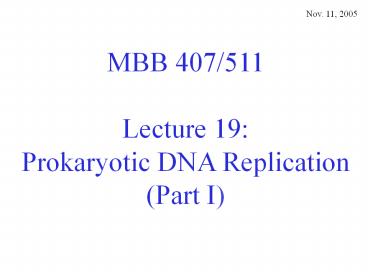MBB 407/511 PowerPoint PPT Presentation
1 / 19
Title: MBB 407/511
1
Nov. 11, 2005
MBB 407/511 Lecture 19 Prokaryotic DNA
Replication (Part I)
2
I. Why Study DNA Replication?
1) To understand canceruncontrolled cell
division (DNA replication)
2) To understand agingcells capable of finite
of doublings
3) To understand diseases related to DNA repair
Example of premature aging NOT caused by a
hereditary disease
a) Blooms Syndrome b) Xeroderma Pigmentosum c)
Werners Syndrome
Keith Richards (of the Rolling Stones)
3
II. Landmarks in the Study of DNA Replication
A. 1953 Watson and Crick
From the structure of DNA they predicted that
the DNA strands could act as templates for the
synthesis of new strands base complementarity
B. 1958 Meselson and Stahl
Three Potential DNA Replication Models
New DNA
Old DNA
4
The Meselson-Stahl Experiment The most beautiful
experiment in biology
Parental
Conclusion DNA is Replicated Semiconservatively
1. The parental strands separate during DNA
replication. 2. Daughter DNA molecules consist of
one new and one old (parental) strand.
5
III. General Features of DNA Replication
All DNA Polymerases
1. require a DNA template and a primer with a 3
OH end (DNA polymerases can only elongate
no de novo initiation of DNA synthesis)
Short RNA primers are needed for initiation in
vivo
2. require dNTPs
3. synthesize DNA in a 5 to 3 direction.
4. require metal ions (Mg2 or Zn2) as cofactors
divalent
The Substrates for DNA Replication
6
The Mechanism of DNA Synthesis
DNA Synthesis Is Exergonic
dNTP (dXMP)n ? (dXMP)n1 PP DG
-3.5 kcal/mole
PP ? 2 P
DG -7 kcal/mole
Total dNTP (dXMP)n ? (dXMP)n1 2 P
DG -10.5 kcal/mole
7
The Role of Metal Ions In DNA Synthesis
8
Steric Constraints Prevent Catalysis of rNTPs
9
Replication of the E. coli Chromosome is
Bidirectional
10
Replication of the E. coli Chromosome is
Semidiscontinuous
Replicates continuously DNA synthesis is going
in same direction as replication fork
Replicates discontinuously DNA synthesis is
going in opposite direction as replication fork
Joined by DNA ligase
Because of the anti-parallel structure of the DNA
duplex, new DNA must be synthesized in the
direction of fork movement in both the 5 to 3
and 3 to 5 directions overall.
However all known DNA polymerases synthesize DNA
in the 5 to 3 direction only.
The solution is semidiscontinuous DNA replication.
11
Now this end is called the thagomizer, after the
late Thag Simmons.
12
Klenow Fragment
DNA Repair
(Errors fixed after DNA replication)
No Proofreading
13
(No Transcript)
14
Nick Translation
5 ? 3 exonuclease activity digests DNA 5 ? 3
polymerase activity replaces the digested DNA
with new DNA
They act together to edit out sections of damaged
DNA
15
(No Transcript)
16
(No Transcript)
17
(No Transcript)
18
Main replicative enzyme
Repair enzyme
19
Roles of DNA Pol III and Pol I in E. coli
Pol IIImain DNA replication enzyme. It exists
as a dimer to coordinate the synthesis
of both the leading and lagging strands at
the replication fork.
Pol Irepair enzyme to remove RNA primers that
initiate DNA synthesis on both
strands. It is need predominantly for maturation
of Okazaki fragments.
1) Removes RNA primers (5?3 Exo) 2) Replaces
the RNA primers with DNA (5?3 Pol 3?5 Exo
proofreading)
gt10 kb
Q Why do Okazaki fragments initiate with RNA
primers?
A Because DNA polymerases require a primer but
cant synthesize them de novo
DNA Pol I
1 kb

